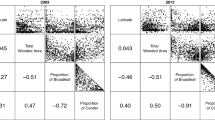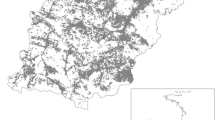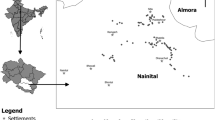Abstract
In the UK, wood cricket (Nemobius sylvestris) is a ‘Species of Conservation Concern’, being restricted to only three areas in southern England. Little information is available on the specific habitat requirements of this species. In 2006, a field investigation within three woodlands on the Isle of Wight was undertaken to identify its habitat preferences. Factors positively influencing wood cricket presence within woodlands included the presence of a well-developed leaf litter layer, relatively low ground vegetation cover and height, low canopy cover and relatively short distances between individual populations. Regression models identified the degree of isolation and variables describing vegetation structure as the main predictors for wood cricket presence within woodland fragments. The results of this study indicate the preference of wood cricket for open wooded edges. Conservation efforts for this species should focus on continuation of regular management activities aimed at providing permanent open edge habitat within woodlands, to maintain viable populations.



Similar content being viewed by others
References
Beugnon G (1980) Daily migrations of the wood cricket Nemobius sylvestris. Environ Entomol 9(6):801–805
Beyer HL (2004) Hawth’s Analysis Tools for ArcGIS. Available via http://www.spatialecology.com/htools/. Accessed July 2005
Binzenhofer B, Schroder B, Strauss B et al (2005) Habitat models and habitat connectivity analysis for butterflies and burnet moths: the example of Zygaena carniolica and Coenonympha arcania. Biol Conserv 126(2):247–259. doi:10.1016/j.biocon.2005.05.009
Bratton J, Andrews J (1991) Invertebrate conservation: principles and their application to broad-leaved woodland. Br Wildl 2(6):335–344
Brouwers NC, Newton AC (2008) The influence of habitat availability and landscape structure on the distribution of wood cricket (Nemobius sylvestris) on the Isle of Wight, UK. Landscape Ecol. doi:10.1007/s10980-008-9298-4
Brouwers NC, Newton AC (in press) Movement rates of woodland invertebrates: a systematic review of empirical evidence. Insect Conserv Divers
Brown VK (1978) Variations in voltinism and diapause intensity in Nemobius sylvestris Orthoptera Gryllidae. J Nat Hist 12(4):461–472. doi:10.1080/00222937800770321
Buse J, Schroder B, Assmann T (2007) Modelling habitat and spatial distribution of an endangered longhorn beetle: a case study for saproxylic insect conservation. Biol Conserv 137(3):372–381. doi:10.1016/j.biocon.2007.02.025
Cohen J (1988) Statistical power analysis for the behavioural sciences. Academic Press, New York
Crooks KR, Sanjayan M (eds) (2006) Connectivity conservation. Cambridge University Press, Cambridge
Defra (2005) Keepers of time: a statement of policy for England’s ancient & native woodland. Defra/Forestry Commission, UK
Engler R, Guisan A, Rechsteiner L (2004) An improved approach for predicting the distribution of rare and endangered species from occurrence and pseudo-absence data. J Appl Ecol 41(2):263–274. doi:10.1111/j.0021-8901.2004.00881.x
English Nature (1998–2006) Ancient Woodland Inventory (Provisional) for England—Digital Boundaries. English Nature, Great Britain. Available via http://www.english-nature.org.uk/pubs/gis/tech_aw.htm. Accessed June 2006
Field A (2005) Discovering statistics using SPSS. SAGE Publications Ltd, London
Fleishman E, Murphy DD, Sjogren-Gulve P (2002) Modeling species richness and habitat suitability for taxa of conservation interest. In: Scott JM et al (eds) Predicting species occurrences: issues of accuracy and scale. Island, Washington, DC, pp 507–517
Forestry Commission (2006) Isle of Wight forest design plan—South East England Forest District 2006–2042. Forestry Commission, UK (draft)
Gabbutt PD (1959) The bionomics of the wood cricket, Nemobius sylvestris (Orthoptera: Gryllidae). J Anim Ecol 28(1):15–42. doi:10.2307/2011
Greatorex-Davies JN, Sparks TH, Hall ML (1994) The response of heteroptera and coleoptera species to shade and aspect in rides of coniferised lowland woods in Southern England. Biol Conserv 67(3):255–273. doi:10.1016/0006-3207(94)90617-3
Gutzwiller KJ (ed) (2002) Applying landscape ecology in biological conservation. Springer Verlag, New York
Hanski IA, Gilpin ME (eds) (1997) Metapopulation biology. Ecology, genetics, and evolution. Academic Press, New York
Harrison S, Taylor AD (1997) Empirical evidence for metapopulation dynamics. In: Hanski IA, Gilpin ME (eds) Metapopulation biology. Ecology, genetics, and evolution. Academic Press, New York, pp 27–42
Heller NE, Gordon DM (2006) Seasonal spatial dynamics and causes of nest movement in colonies of the invasive Argentine ant (Linepithema humile). Ecol Entomol 31(5):499–510. doi:10.1111/j.1365-2311.2006.00806.x
Koehler G, Samietz J (2006) Semivoltine entwicklung der waldgrille, Nemobius sylvestris (Bosc.), an ihrem mitteldeutschen Arealrand (Semivoltine development of the cricket, Nemobius sylvestris (Bosc.) in the central Germany border region). Articulata 21(2):183–194
Konvicka M, Novak J, Benes J et al. (2008) The last population of the woodland brown butterfly (Lopinga achine) in the Czech Republic: habitat use, demography and site management. J Insect Conserv 12(5):549–560
Matern A, Drees C, Kleinwachter M et al (2007) Habitat modelling for the conservation of the rare ground beetle species Carabus variolosus (Coleoptera, Carabidae) in the riparian zones of headwaters. Biol Conserv 136(4):618–627
Morvan R, Campan R (1976) Displacement of ground crickets: conditions of acquisition and maintenance of a dominant orientation (Les deplacements du grillon des bois: conditions d’acquisition et de maintien d’une orientation dominante). Terre Vie 30(2):276–294
NBN Gateway (2007) National Biodiversity Network developed by CEH and JNCC, 2004. Available via http://www.searchnbn.net/. Accessed November 2007
Pallant J (2007) SPSS survival manual. Open University Press, Berkshire
Proess R, Baden R (2000) Survey of the orthopteran species Barbitistes serricauda (Fabricius, 1798), Leptophyes punctatissima (Bosc, 1972), Meconema thalassinum (De Geer, 1773) and Nemobius sylvestris (Bosc, 1792) in Luxembourg (Insecta, Saltatoria). Bull Soc Nat Luxemb 100:159–170
Ranius T (2000) Minimum viable metapopulation size of a beetle, Osmoderma eremita, living in tree hollows. Anim Conserv 3(1):37–43. doi:10.1111/j.1469-1795.2000.tb00085.x
Richards TJ (1952) Nemobius sylvestris in S.E. Devon. Entomologist 85:83–87 108–111; 136–141; 161–166
Rieske LK, Buss LJ (2001) Influence of site on diversity and abundance of ground- and litter-dwelling Coleoptera in Appalachian oak-hickory forests. Environ Entomol 30(3):484–494
Rukke BA (2000) Effects of habitat fragmentation: increased isolation and reduced habitat size reduces the incidence of dead wood fungi beetles in a fragmented forest landscape. Ecography 23(4):492–502. doi:10.1034/j.1600-0587.2000.230411.x
Rukke BA, Midtgaard F (1998) The importance of scale and spatial variables for the fungivorous beetle Bolitophagus reticulatus (Coleoptera, Tenebrionidae) in a fragmented forest landscape. Ecography 21(6):561–572. doi:10.1111/j.1600-0587.1998.tb00548.x
Siitonen J, Saaristo L (2000) Habitat requirements and conservation of Pytho kolwensis, a beetle species of old-growth boreal forest. Biol Conserv 94(2):211–220. doi:10.1016/S0006-3207(99)00174-3
Smith S, Gilbert J (2003) National inventory of woodland and trees—Great Britain. Forestry Commission, Edinburgh, pp 1–55
Sorvari J, Hakkarainen H (2007) Wood ants are wood ants: deforestation causes population declines in the polydomous wood ant Formica aquilonia. Ecol Entomol 32(6):707–711. doi:10.1111/j.1365-2311.2007.00921.x
Spencer JW, Kirby KJ (1992) An inventory of ancient woodland for England and Wales. Biol Conserv 62:77–93. doi:10.1016/0006-3207(92)90929-H
Sroka K, Finch O-D (2006) Ground beetle diversity in ancient woodland remnants in north-western Germany (Coleoptera, Carabidae). J Insect Conserv 10(4):335–350. doi:10.1007/s10841-006-9008-y
Strauss B, Biedermann R (2005) The use of habitat models in conservation of rare and endangered leafhopper species (Hemiptera, Auchenorrhyncha). J Insect Conserv 9(4):245–259. doi:10.1007/s10841-005-8818-7
Tabachnick BG, Fidell LS (2001) Using multivariate statistics. Allyn & Bacon, Boston
Thomas CD (1994) Extinction, colonization, and metapopulations: environmental tracking by rare species. Conserv Biol 8(2):373–378. doi:10.1046/j.1523-1739.1994.08020373.x
Thomas CD, Thomas JA, Warren MS (1992) Distributions of occupied and vacant butterfly habitats in fragmented landscapes. Oecologia 92(4):563–567. doi:10.1007/BF00317850
Warren MS, Key RS (1991) Woodlands: past, present and potential for insects. In: Collins NM, Thomas JA (eds) The conservation of insects and their habitats. Academic Press, London, pp 155–211
Acknowledgments
We like to thank Sallie Bailey, Timothy New and two anonymous referees for their thoughtful comments on an earlier version of this manuscript. We also like to thank the Forestry Commission and the Scottish Forestry Trust for funding this research. Furthermore, we like to thank the Forestry Commission (South East England Forest District), The National Trust (Mottistone, Isle of Wight) and the People’s Trust for Endangered Species (PTES) (London, UK) for working in their woodlands on the Isle of Wight.
Author information
Authors and Affiliations
Corresponding author
Rights and permissions
About this article
Cite this article
Brouwers, N.C., Newton, A.C. Habitat requirements for the conservation of wood cricket (Nemobius sylvestris) (Orthoptera: Gryllidae) on the Isle of Wight, UK. J Insect Conserv 13, 529–541 (2009). https://doi.org/10.1007/s10841-008-9199-5
Received:
Accepted:
Published:
Issue Date:
DOI: https://doi.org/10.1007/s10841-008-9199-5




